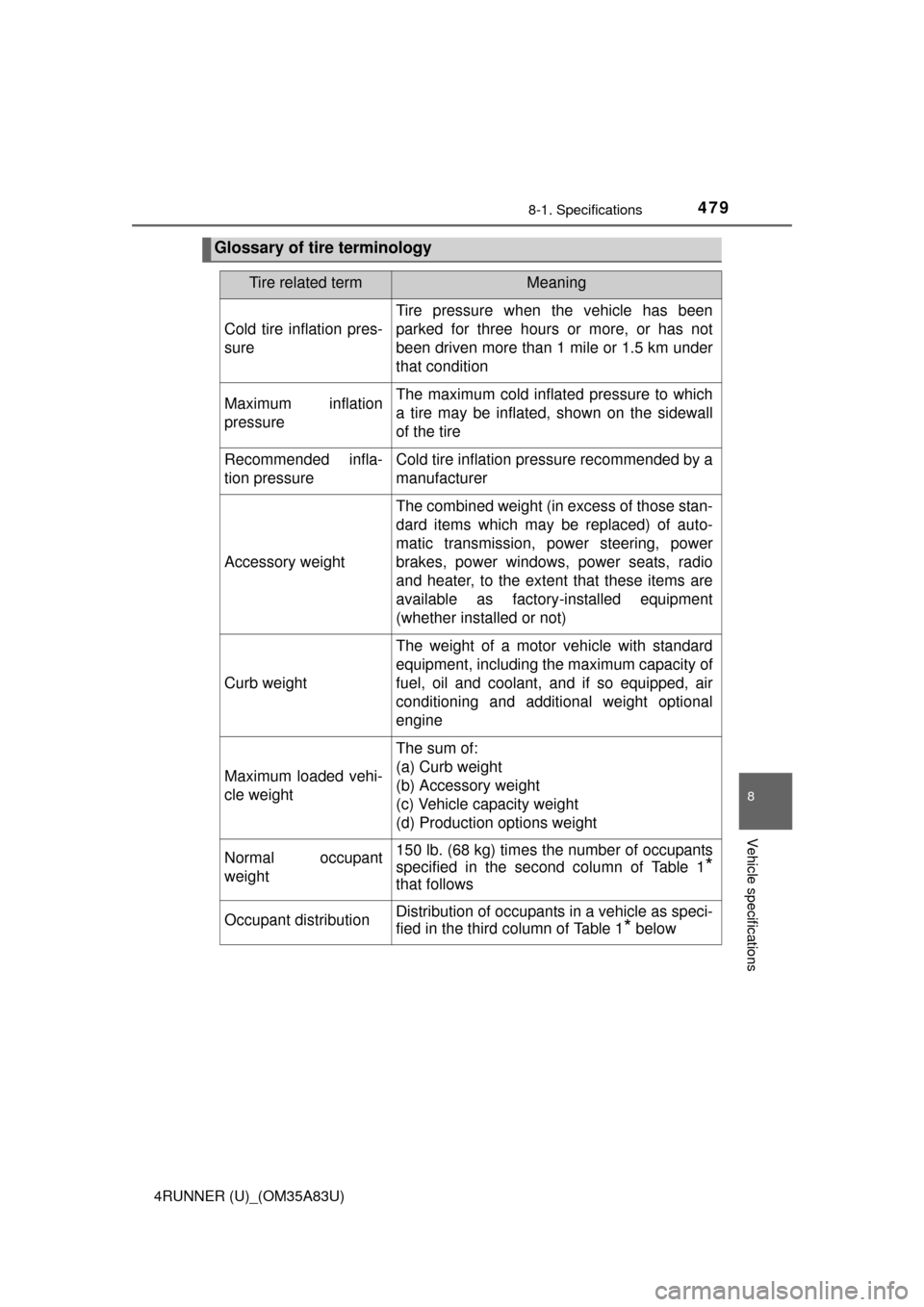Page 364 of 530

3626-3. Do-it-yourself maintenance
4RUNNER (U)_(OM35A83U)
The coolant level is satisfactory if it is between the “F” and “L” lines on
the reservoir when the engine is cold.
Reservoir cap
“F” line
“L” line
If the level is on or below the “L”
line, add coolant up to the “F” line.
(P. 455)
■ Coolant selection
Only use “Toyota Super Long Life Coolant” or a similar high quality ethylene
glycol based non-silicate, non-amine, non-nitrite, and non-borate coolant with
long-life hybrid organic acid technology.
U.S.A.:
“Toyota Super Long Life Coolant” is a mixture of 50% coolant and 50% deion-
ized water. (Minimum temperature: -31 F [-35 C])
Canada:
“Toyota Super Long Life Coolant” is a mixture of 55% coolant and 45% deion-
ized water. (Minimum temperature: -44 F [-42 C])
For more details about engine coolant, contact your Toyota dealer.
■ If the coolant level drops within a short time of replenishing
Visually check the radiator, hoses, engine coolant reservoir caps, drain cock
and water pump.
If you cannot find a leak, have your Toyota dealer test the cap and check for
leaks in the cooling system.
Engine coolant
1
2
3
Page 365 of 530

3636-3. Do-it-yourself maintenance
6
Maintenance and care
4RUNNER (U)_(OM35A83U)
Check the radiator and condenser and clear away any foreign objects.
If either of the above parts is ex tremely dirty or you are not sure of
their condition, have yo ur vehicle inspected by your Toyota dealer.
CAUTION
■When the engine is hot
Do not remove the engine coolant reservoir cap or the radiator cap.
(P. 456)
The cooling system may be under pressure and may spray hot coolant if the
cap is removed, causing serious injuries, such as burns.
NOTICE
■ When adding coolant
Coolant is neither plain water nor straight antifreeze. The correct mixture of
water and antifreeze must be used to provide proper lubrication, corrosion
protection and cooling. Be sure to read the antifreeze or coolant label.
■ If you spill coolant
Be sure to wash it off with water to prevent it from damaging parts or paint.
Radiator and condenser
CAUTION
■When the engine is hot
Do not touch the radiator or condenser as they may be hot and cause seri\
-
ous injuries, such as burns.
Page 418 of 530
4167-2. Steps to take in an emergency
4RUNNER (U)_(OM35A83U)
●Fluid leaks under the vehicle.
(Water dripping from the air co nditioning after use is normal.)
● Flat-looking tires or uneven tire wear
● Engine coolant temperature gauge needle continually points higher
than normal.
● Changes in exhaust sound
● Excessive tire squeal when cornering
● Strange noises related to the suspension system
● Pinging or other noises related to the engine
● Engine missing, stumbling or running roughly
● Appreciable loss of power
● Vehicle pulls heavily to one side when braking
● Vehicle pulls heavily to one side when driving on a level road
● Loss of brake effectiveness, spon gy feeling, pedal almost touches
the floor
If you think something is wrong
If you notice any of the follow ing symptoms, your vehicle proba-
bly needs adjustment or repair. Contact your Toyota dealer as
soon as possible.
Visible symptoms
Audible symptoms
Operational symptoms
Page 457 of 530

4557-2. Steps to take in an emergency
7
When trouble arises
4RUNNER (U)_(OM35A83U)
●The needle of the engine coolant temperature gauge ( P. 8 1 )
enters the red zone or a loss of engine power is experienced.
(For example, the vehicle speed does not increase.)
● Steam comes out from under the hood.
Stop the vehicle in a safe place and turn off the air conditioning sys-
tem, and then stop the engine.
If you see steam:
Carefully lift the hood after the steam subsides.
If you do not see steam:
Carefully lift the hood.
After the engine has cooled
down sufficient ly, inspect the
hoses and radiator core (radia-
tor) for any leaks.
Radiator
Cooling fan
If a large amount of coolant leaks,
immediately contact your Toyota
dealer.
The coolant level is satisfactory
if it is between the “F” and “L”
lines on the reservoir.
Reservoir
“F” line
“L” line
Radiator cap
If your vehicle overheats
The following may indicate that your vehicle is overheating:
Correction procedures
1
2
3
1
2
4
1
2
3
4
Page 458 of 530

4567-2. Steps to take in an emergency
4RUNNER (U)_(OM35A83U)
Add engine coolant if neces-
sary. (P. 358)
Water can be used in an emer-
gency if engine coolant is unavail-
able.
Start the engine and check that the radiator cooling fan operate and
to check for coolant leaks fr om the radiator or hoses.
If the fan are not operating:
Stop the engine immediately and contact your Toyota dealer.
If the fan are operating:
Have the vehicle in spected at the nearest Toyota dealer.
5
CAUTION
■When inspecting under the hood of your vehicle
Observe the following precautions.
Failure to do so may result in serious injury such as burns.
● If steam is seen coming from under the hood, do not open the hood until
the steam has subsided. The engine compartment may be very hot.
● Keep hands and clothing (especially a tie, a scarf or a muffler) away from
the fans and belts.
6
7
●Do not loosen the radiator cap and the
coolant reservoir cap while the engine
and radiator are hot.
High temperature steam or coolant
could spray out.
Page 459 of 530
4577-2. Steps to take in an emergency
7
When trouble arises
4RUNNER (U)_(OM35A83U)
NOTICE
■When adding engine coolant
Wait until the engine has cooled down before adding engine coolant.
When adding coolant, do so slowly. Adding cool coolant to a hot engine too
quickly can cause damage to the engine.
■ To prevent damage to the cooling system
Observe the following precautions:
● Avoid contaminating the coolant with foreign matter (such as sand or dust
etc.).
● Do not use any coolant additives.
Page 481 of 530

4798-1. Specifications
8
Vehicle specifications
4RUNNER (U)_(OM35A83U)
Glossary of tire terminology
Tire related termMeaning
Cold tire inflation pres-
sure
Tire pressure when the vehicle has been
parked for three hours or more, or has not
been driven more than 1 mile or 1.5 km under
that condition
Maximum inflation
pressureThe maximum cold inflated pressure to which
a tire may be inflated, shown on the sidewall
of the tire
Recommended infla-
tion pressureCold tire inflation pressure recommended by a
manufacturer
Accessory weight
The combined weight (in excess of those stan-
dard items which may be replaced) of auto-
matic transmission, power steering, power
brakes, power windows, power seats, radio
and heater, to the extent that these items are
available as factory-installed equipment
(whether installed or not)
Curb weight
The weight of a motor vehicle with standard
equipment, including the maximum capacity of
fuel, oil and coolant, and if so equipped, air
conditioning and additional weight optional
engine
Maximum loaded vehi-
cle weight
The sum of:
(a) Curb weight
(b) Accessory weight
(c) Vehicle capacity weight
(d) Production options weight
Normal occupant
weight150 lb. (68 kg) times the number of occupants
specified in the second column of Table 1
*
that follows
Occupant distributionDistribution of occupants in a vehicle as speci-
fied in the third column of Table 1
* below
Page 519 of 530

517Alphabetical index
4RUNNER (U)_(OM35A83U)
Eco Driving Indicator ................ 83
EDR (Event data recorder) ........ 10
Electronic key ............................ 94Battery-saving function ......... 110
If the electronic key does not
operate properly ................. 450
Replacing the battery ............ 385
Emergency, in case of If the electronic key does not operate
properly .............................. 450
If the engine will not start ...... 446
If the shift lever cannot be shifted from P .... 448
If the vehicle battery is discharged .......................... 452
If the warning buzzer sounds ................................ 418
If the warning light turns
on ....................................... 418
If the warning message is displayed......................... 426
If you cannot operate back door opener ............... 449
If you have a flat tire ............. 433
If you think something is wrong .............................. 416
If your vehicle becomes stuck ................................... 458
If your vehicle has to be stopped in an emergency ... 409
If your vehicle needs
to be towed ......................... 411
If your vehicle overheats ....... 455 Emergency flashers ................ 408
Engine
Accessory mode ................... 196
Compartment ........................ 357
Engine switch ............... 192, 195
Hood ..................................... 356
How to start the engine ........................ 192, 195
Identification number ............ 461
If the engine will not start ...... 446
Ignition switch (engine switch) ........... 192, 195
Overheating .......................... 455
Engine coolant......................... 362
Capacity................................ 464
Checking............................... 362
Preparing and checking before winter ...................... 269
Engine coolant temperature gauge ....................................... 81
Engine immobilizer system ...... 70
Engine oil ................................. 359 Capacity................................ 463
Checking............................... 359
Preparing and checking
before winter ...................... 269
Engine switch .................. 192, 195
Event data recorder (EDR)........ 10
E